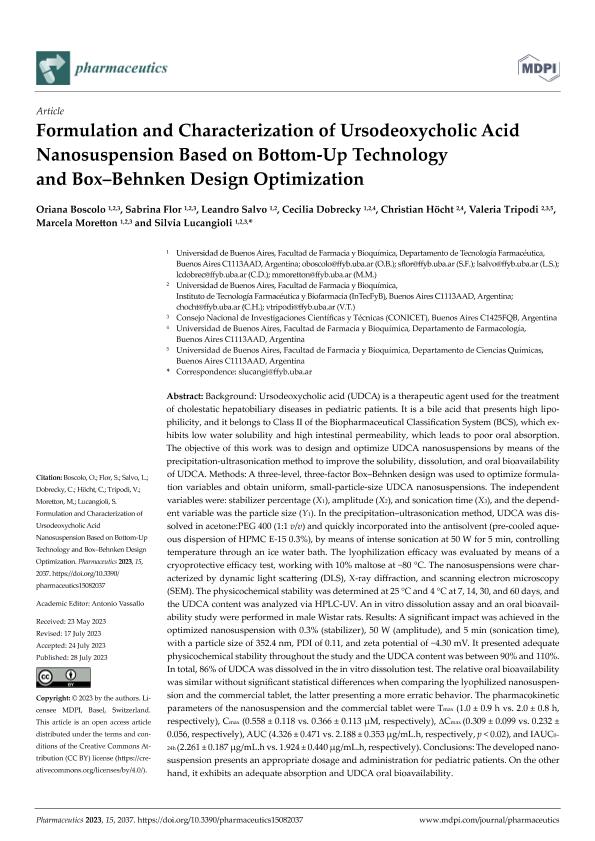Artículo
Formulation and Characterization of Ursodeoxycholic Acid Nanosuspension Based on Bottom-Up Technology and Box–Behnken Design Optimization
Boscolo, Oriana ; Flor, Sabrina Andrea
; Flor, Sabrina Andrea ; Salvo, Leandro; Dobrecky, Cecilia Beatriz; Höcht, Christian; Tripodi, Valeria Paula
; Salvo, Leandro; Dobrecky, Cecilia Beatriz; Höcht, Christian; Tripodi, Valeria Paula ; Moretton, Marcela Analía
; Moretton, Marcela Analía ; Lucangioli, Silvia Edith
; Lucangioli, Silvia Edith
 ; Flor, Sabrina Andrea
; Flor, Sabrina Andrea ; Salvo, Leandro; Dobrecky, Cecilia Beatriz; Höcht, Christian; Tripodi, Valeria Paula
; Salvo, Leandro; Dobrecky, Cecilia Beatriz; Höcht, Christian; Tripodi, Valeria Paula ; Moretton, Marcela Analía
; Moretton, Marcela Analía ; Lucangioli, Silvia Edith
; Lucangioli, Silvia Edith
Fecha de publicación:
07/2023
Editorial:
Multidisciplinary Digital Publishing Institute
Revista:
Pharmaceutics
e-ISSN:
1999-4923
Idioma:
Inglés
Tipo de recurso:
Artículo publicado
Clasificación temática:
Resumen
Background: Ursodeoxycholic acid (UDCA) is a therapeutic agent used for the treatment of cholestatic hepatobiliary diseases in pediatric patients. It is a bile acid that presents high lipophilicity, and it belongs to Class II of the Biopharmaceutical Classification System (BCS), which exhibits low water solubility and high intestinal permeability, which leads to poor oral absorption. The objective of this work was to design and optimize UDCA nanosuspensions by means of the precipitation-ultrasonication method to improve the solubility, dissolution, and oral bioavailability of UDCA. Methods: A three-level, three-factor Box–Behnken design was used to optimize formulation variables and obtain uniform, small-particle-size UDCA nanosuspensions. The independent variables were: stabilizer percentage (X1), amplitude (X2), and sonication time (X3), and the dependent variable was the particle size (Y1). In the precipitation–ultrasonication method, UDCA was dissolved in acetone:PEG 400 (1:1 v/v) and quickly incorporated into the antisolvent (pre-cooled aqueous dispersion of HPMC E-15 0.3%), by means of intense sonication at 50 W for 5 min, controlling temperature through an ice water bath. The lyophilization efficacy was evaluated by means of a cryoprotective efficacy test, working with 10% maltose at −80 °C. The nanosuspensions were characterized by dynamic light scattering (DLS), X-ray diffraction, and scanning electron microscopy (SEM). The physicochemical stability was determined at 25 °C and 4 °C at 7, 14, 30, and 60 days, and the UDCA content was analyzed via HPLC-UV. An in vitro dissolution assay and an oral bioavailability study were performed in male Wistar rats. Results: A significant impact was achieved in the optimized nanosuspension with 0.3% (stabilizer), 50 W (amplitude), and 5 min (sonication time), with a particle size of 352.4 nm, PDI of 0.11, and zeta potential of −4.30 mV. It presented adequate physicochemical stability throughout the study and the UDCA content was between 90% and 110%. In total, 86% of UDCA was dissolved in the in vitro dissolution test. The relative oral bioavailability was similar without significant statistical differences when comparing the lyophilized nanosuspension and the commercial tablet, the latter presenting a more erratic behavior. The pharmacokinetic parameters of the nanosuspension and the commercial tablet were Tmax (1.0 ± 0.9 h vs. 2.0 ± 0.8 h, respectively), Cmax (0.558 ± 0.118 vs. 0.366 ± 0.113 µM, respectively), ΔCmax (0.309 ± 0.099 vs. 0.232 ± 0.056, respectively), AUC (4.326 ± 0.471 vs. 2.188 ± 0.353 µg/mL.h, respectively, p < 0.02), and IAUC0–24h (2.261 ± 0.187 µg/mL.h vs. 1.924 ± 0.440 µg/mL.h, respectively). Conclusions: The developed nanosuspension presents an appropriate dosage and administration for pediatric patients. On the other hand, it exhibits an adequate absorption and UDCA oral bioavailability.
Archivos asociados
Licencia
Identificadores
Colecciones
Articulos(OCA HOUSSAY)
Articulos de OFICINA DE COORDINACION ADMINISTRATIVA HOUSSAY
Articulos de OFICINA DE COORDINACION ADMINISTRATIVA HOUSSAY
Citación
Boscolo, Oriana; Flor, Sabrina Andrea; Salvo, Leandro; Dobrecky, Cecilia Beatriz; Höcht, Christian; et al.; Formulation and Characterization of Ursodeoxycholic Acid Nanosuspension Based on Bottom-Up Technology and Box–Behnken Design Optimization; Multidisciplinary Digital Publishing Institute; Pharmaceutics; 15; 8; 7-2023; 1-18
Compartir
Altmétricas



